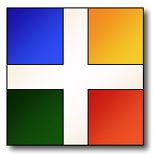 Another template courtesy of "Not by Appointment" !
Another template courtesy of "Not by Appointment" !"During the lengthy process of retraining and refitting l'armee de l'Oise at Thionville, it was necessary to keep the enemy from looking to our frontier with an eye for mischief all the time that the defences of France were at at such a nadir. It was imperative to prevent the forces of the Pragmatic Alliance from taking advantage of our current deplorable state, and, if possible, to deceive them as to the true extent of our discomfiture.
For this service, we needed men of energy and enterprise, and we had no further to look for such hearty individuals than in our new band of hussars and their chef, Count Horthy Emil Sarkozy.
The Count soon demonstrated the wisdom of our having accepted his services, for no sooner had he joined our camp, than he began a series of raids, moonlight strikes, bluffs and other activities all along the part of the frontier that seperated the two armies.
It was quite remarkable to us officers, our being so used to conditions of service with the French army, with what little fanfare Count Sarkozy and his hussars would make their departure. Leaving in the early hours before sunrise, no sooner would they ride out of the camp than they would seemingly vanish into the very ether; burdened neither by train nor baggage, other than what the men could strap to their horses.
We would hear no news of them for days at a time. And then, with no harbinger or rumour heralding their approach, they would just as suddenly reappear, with no more ceremony as would have been the case had they merely been out on a morning to exercise their mounts.
Upon his return, Count Sarkozy would first attend to watering his horses and to obtaining food for his men. He would then directly make his way to my quarters, still covered in the accumulated grime of his latest adventure, where after brusquely paying his respects to the assembled company, he would then commence to present me with his latest souvenirs; a chest of maps here, some intelligence on enemy forces there, and even from time to time a valuable prisoner. (This included on one occasion none other than Graf Kristoph von Meissenplatz- a celebrated officer late in the service of the Duke of Hesse-Rheingelden- in whose company I then had the pleasure to dine.)
And always, Sarkozy's hussars- both men and horses- would return burdened with chests of coin, jewelry, and sacks of gold and other valuables, so that they were soon as rich as corsairs.
Which was as well, as in time I found myself in a position to bankroll the army and to pay for proper equipment and provisioning. A soldier may fight for honour or his comrades, but an army marches, alas, on money. My headaches at the time from dealing with the parsimonious scrubs in the Ministry of War were at their worst, and financing was always in short supply in those days.
I therefore did not press the Count too closely on how or where these most likely ill-gotten gains originated, but in my capacity as Prince Ecclesiastical of the Bishopric of St. Vignobles, I was always sure to give a brief benediction at Mass for those souls who may have had to endure the suffering that can befall the lot of those who have been privileged to "contribute" to the cause of Good King Louis.
Also long-suffering indeed was the Conte d'Aglianico, a most brave and professional lieutenant of mine, under whose direct command Sarkozy found himself (inasmuch as our wild Hungarian deigned submit to our command; or indeed, to any authority at all).
Many were the times that this gallant officer was called upon to intervene in the constant stream of disputes that arose between Sarkozy's band of uniformed brigands and the local populace. Through the judicious application of honeyed words, favours, bribes -and, when necessary, dark threats- he accomplished minor marvels of diplomacy, shielding me, along with the rest of my overburdened staff, from the endless deputations of affronted local counsellors and other such disaffected citizenry.
Nonetheless, it was acknowledged by all that the value of Sarkozy's actions against the enemy were proving their worth, and he soon developed a fearsome reputation on the far bank of the Rhine. Captured documents revealed that the enemy were having to send additional forces to meet the threat. Indeed, none other than the esteemed M. de Saxe was soon to write to me and to the War Ministry, asking that the raids continue as they were serving to draw reinforcements away from the Flanders theatre that would otherwise be ranged against him in his upcoming campaign there.
The proposal was soon made that Sarkozy's band be increased by the recruiting of two extra squadrons of hussars to that of a full regiment, and that a unit of Pandours be raised. These latter to be recruited from prisoners taken in recent actions in Bavaria- men whose dedication to the Habsburg crown was considered to have taken less of a hold on their hearts than did the prospect of a full purse while serving under the illustrious, and increasingly renowned, Count Sarkozy."





























